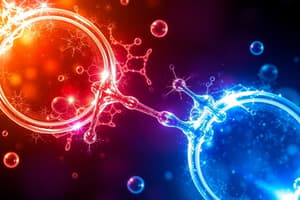Podcast
Questions and Answers
What type of bond occurs when two atoms share one pair of electrons?
What type of bond occurs when two atoms share one pair of electrons?
- Ionic bond
- Double covalent bond (correct)
- Hydrogen bond
- Metallic bond
In which type of bonding are electrons delocalized within the crystal structure?
In which type of bonding are electrons delocalized within the crystal structure?
- Coordinate covalent bonding
- Double covalent bonding
- Triple covalent bonding
- Metallic bonding (correct)
What is the unique characteristic of hydrogen bonding?
What is the unique characteristic of hydrogen bonding?
- It is found in complex molecules with central metal ions
- It involves the transfer of electrons from one atom to another
- It shares two pairs of electrons between two atoms
- It occurs between hydrogen atoms and other electronegative atoms (correct)
Which type of bonding is responsible for the high electrical and thermal conductivity of metals?
Which type of bonding is responsible for the high electrical and thermal conductivity of metals?
What is coordinate covalent bonding also known as?
What is coordinate covalent bonding also known as?
What type of bonding involves the sharing of electrons between atoms?
What type of bonding involves the sharing of electrons between atoms?
In ionic bonding, what happens to the electrons between metals and non-metals?
In ionic bonding, what happens to the electrons between metals and non-metals?
What forces hold the resulting positive and negative ions together in ionic bonding?
What forces hold the resulting positive and negative ions together in ionic bonding?
If electrons are shared unequally between atoms, what type of covalent bond is formed?
If electrons are shared unequally between atoms, what type of covalent bond is formed?
How is the bond strength in covalent bonding determined?
How is the bond strength in covalent bonding determined?
Flashcards are hidden until you start studying
Study Notes
Chemical Bonding: Understanding the Foundation of Matter
Chemical bonding lies at the heart of our understanding of the physical and chemical world, allowing us to describe and predict the behavior of substances in their everyday forms as well as at the nanoscopic level. In this article, we'll delve into the fascinating realm of chemical bonding, exploring how atoms join together to form molecules and the types of bonds that result.
Ionic Bonding
In ionic bonding, electrons are transferred between atoms to create charged ions that are attracted to each other. This bonding occurs between metals and non-metals, where the less electronegative metal loses electrons to achieve a stable electron configuration, while the more electronegative non-metal gains electrons to do the same. The resulting positive and negative ions are held together by electrostatic forces.
Covalent Bonding
Covalent bonding, on the other hand, arises from the sharing of electrons between atoms, resulting in stable electron configurations for each atom involved. The bond strength is determined by the number of electrons shared and their distribution between the atoms. In this type of bonding, the electrons are shared equally between the atoms, and the bond is described as non-polar if the electrons are shared equally and polar if they are shared unequally.
Types of Covalent Bonds
Covalent bonds aren't all the same. There are three main types of covalent bonds:
- Single covalent bonds: A single bond occurs when two atoms share one pair of electrons.
- Double covalent bonds: A double bond occurs when two atoms share two pairs of electrons.
- Triple covalent bonds: A triple bond occurs when two atoms share three pairs of electrons.
Coordinate Covalent Bonding
Coordinate covalent bonding, also known as dipole bonding or coordinate bonding, involves the transfer of electrons from one atom to another, with the electrons being shared between the bonded atoms. This type of bond is typically found in complex molecules, such as those containing central metal ions.
Metallic Bonding
In metallic bonding, electrons are not localized between specific pairs of atoms, but rather are delocalized within the crystal structure. The positively charged metal ions are held together by the electrostatic attraction of the delocalized electrons. Metallic bonding is responsible for the unique properties of metals, such as their high electrical and thermal conductivity.
Hydrogen Bonding
Hydrogen bonding is a unique type of bonding that occurs between hydrogen atoms, which are covalently bonded to electronegative atoms, and other electronegative atoms. The electronegative atom pulls the electron density in the covalent bond more towards itself, thus creating a partially positive hydrogen atom. This partially positive hydrogen atom interacts with the lone pairs or partially negative sites on other electronegative atoms, resulting in hydrogen bonding.
Summary
In summary, chemical bonding is the foundation of chemistry, and it allows us to understand and predict the behavior of matter. Ionic, covalent, and metallic bonding are the primary types of bonding, and each has its unique characteristics. Additionally, coordinate covalent and hydrogen bonding are two more types of bonding that are important in specific contexts. By understanding these various types of bonding, we can gain insight into the properties and reactions of substances, making chemistry a fascinating and useful field of study.
Studying That Suits You
Use AI to generate personalized quizzes and flashcards to suit your learning preferences.




